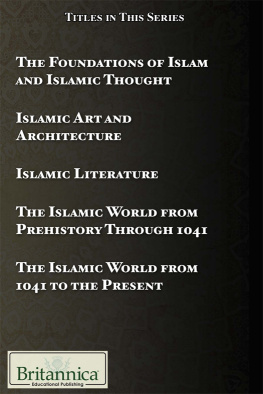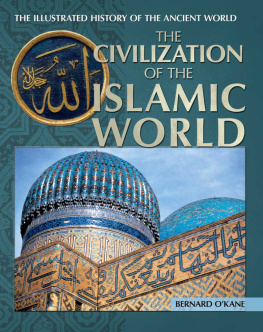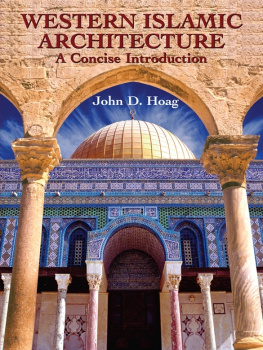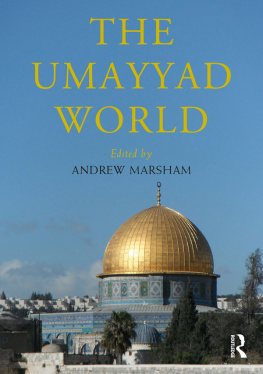
Published in 2018 by Britannica Educational Publishing (a trademark of Encyclopdia Britannica, Inc.) in association with The Rosen Publishing Group, Inc.
29 East 21st Street, New York, NY 10010
Copyright 2018 by Encyclopdia Britannica, Inc. Britannica, Encyclopdia Britannica, and the Thistle logo are registered trademarks of Encyclopdia Britannica, Inc. All rights reserved.
Rosen Publishing materials copyright 2018 The Rosen Publishing Group, Inc. All rights reserved.
Distributed exclusively by Rosen Publishing.
To see additional Britannica Educational Publishing titles, go to rosenpublishing.com.
First Edition
Britannica Educational Publishing
J.E. Luebering: Executive Director, Core Editorial
Andrea R. Field: Managing Editor, Comptons by Britannica
Rosen Publishing
Amelie von Zumbusch: Editor
Nelson S: Art Director
Brian Garvey: Series Designer
Cindy Reiman: Photography Manager
Nicole DiMella: Photo Researcher
Library of Congress Cataloging-in-Publication Data
Names: Osier, Peter, editor.
Title: Islamic art and architecture / [editor] Peter Osier.
Description: Britannica Educational Publishing : New York, NY, 2018. |
Series: The Britannica guide to Islam | Includes bibliographical references and index.
Identifiers: LCCN 2016053714 | ISBN 9781680486148 (eBook)
Subjects: LCSH: Islamic artHistory. | Islamic architectureHistory.
Classification: LCC N6260 .I822 2018 | DDC 704/.088297dc23
LC record available at https://lccn.loc.gov/2016053714
Manufactured in the United States of America
Photo credits: Cover, p. 1 Prazis/Shutterstock.com; pp. 6-7 Jesse Durocher/Moment/Getty Images; p. 15 P Deliss/Corbis Documentary/Getty Images; p. 17 Pascal Deloche/Corbis Documentary/Getty Images; p. 27 semultura/Fotolia; p. 29 Archivo Mas, Barcelona; p. 32 A.F. Kersting; p. 33 Marc Garanger/Corbis Documentary/Getty Images; p. 36 Ryan Rodrick Beiler/Shutterstock.com; p. 42 Matej Kastelic/Shutterstock.com; p. 45 DEA/G. Dagli Orti/DeAgostini/Getty Images; p. 47 CiccioneRapho/Photo Researchers; p. 49 De Agostini Picture Library/Getty Images; p. 56 Scott D. Haddow/Moment Open/Getty Images; p. 60 Werner Forman/Universal Images Group/Getty Images; p. 67 JTB Photo/Universal Images Group/Getty Images; p. 68 Roland and Sabrina MichaudRapho/Photo Researchers; p. 72 Ara Guler, Istanbul; p. 74 Courtesy of the Bibliotheque Nationale, Paris; pp. 76, 98 Courtesy of the Victoria and Albert Museum, London; photograph John Webb; p. 78 Rafael Ramirez/Fotolia; p. 83 Michel Setboun/Corbis Documentary/Getty Images; p. 85 Angelo Hornak/Alamy Stock Photo; p. 88 JupiterimagesPhotos.com/Thinkstock; p. 92 Courtesy of the Trustees of the British Library; p. 97 muratart/Shutterstock.com; p. 101 javarman/Fotolia; p. 103 Courtesy of the Victoria and Albert Museum, London; p. 106 TMAX/Fotolia; p. 111 P. Chandra; back cover, pp. 3-5 background design javarman/Shutterstock.com; interior pages border design Azat1976/Shutterstock.com

W hat, exactly, is Islamic art? When discussing Islamic art, it is first essential to realize that no ethnic group or geographical area was Muslim from the beginning. There is no Islamic art in the way there is a Chinese art or a French art. Nor is it simply a period art, like Gothic art or Baroque art, for once a land or an ethnic entity became Muslim, it remained Muslim (with just a small number of exceptions, such as Spain or Sicily). Political and social events transformed a number of lands with a variety of earlier histories into Muslim lands. But because early Islam as such did not have an artistic style its own, each area could continue, in fact often did continue, whatever modes of creativity it already had acquired. It may then not be appropriate at all to talk about the visual arts of Islamic peoples, and one could instead consider separately each of the areas that became Muslim: Spain, North Africa, Egypt, Syria, Mesopotamia, Iran, Anatolia, and India. Such, in fact, has been the direction taken by some scholarship. Even though tainted at times with parochial nationalism, that approach has been useful in that it has focused attention on a number of permanent features in different regions of Islamic lands that are older than and independent from the faith itself and from the political entity created by it. Iranian art, in particular, exhibits a number of features (certain themes such as the representation of birds or an epic tradition in painting) that owe little to its Islamic character since the 7th century. Ottoman art shares a Mediterranean tradition of architectural conception with Italy rather than with the rest of the Muslim world.
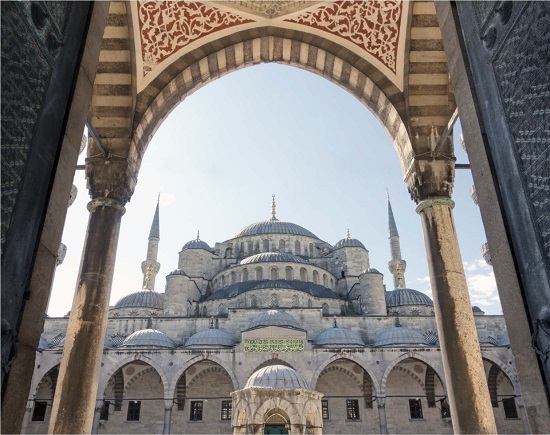
Many of the masterpieces of Islamic architecture are mosques. The Sultan Ahmed Cami, in Istanbul, Turkey, is the work of architect Mehmed Aa. The design of the mosquecalled the Blue Mosque because of the colour of its tile workis perfectly symmetrical.
If one looks at the art of Islamic lands from a different perspective, though, a totally different picture emerges. The perspective is that of the lands that surround the Muslim world or of the times that preceded its formation. For even if there are ambiguous examples, most observers can recognize a flavour, a mood in Islamic visual arts that is distinguishable from what is known in East Asia (China, Korea, and Japan) or in the Christian West. This mood or flavor has been called decorative, for it seems at first glance to emphasize an immense complexity of surface effects without apparent meanings attached to the visible motifs. But it has other characteristics as well: it is often colourful, both in architecture and in objects; it avoids representations of living things; it gives much prominence to the work of artisans and counts among its masterpieces not merely works of architecture or of painting but also the creations of weavers, potters, and metalworkers. The problem is whether these uniquenesses of Islamic art, when compared with other artistic traditions, are the result of the nature of Islam or of some other factor or series of factors.
Each artistic tradition has tended to develop its own favourite mediums and techniques. Some, such as architecture, are automatic needs of every culture, and it is in the medium of architecture that some of the most characteristically Islamic works of art are found. Other techniques have different degrees of importance in different traditions. Sculpture in the round hardly existed as a major art form in the Islamic world, while wall painting existed but has generally been poorly preserved. The great Islamic art of painting was the illustration of books. The unique feature of Islamic techniques is the astounding development taken by the decorative artssuch as woodwork, glass, ceramics, metalwork, and textiles. New techniques were invented and spread throughout the Muslim worldat times even beyond its frontiers. In dealing with Islam, therefore, it is quite incorrect to think of those techniques as the minor arts, for the amount and intensity of creative energies spent on the decorative arts transformed them into major artistic forms, and their significance in defining a profile of the aesthetic and visual language of Islamic peoples is far greater than in the instances of many other cultures. Furthermore, because, for a variety of reasons to be discussed later, the Muslim world did not develop until quite late the notion of noble arts, the decorative arts have reflected far better the needs and ambitions of the culture as a whole. The kind of conclusion that can be reached about Islamic civilization through its visual arts thus extends far deeper than is usual in the study of an artistic tradition, and it requires a combination of archaeological, art-historical, and textual information.

